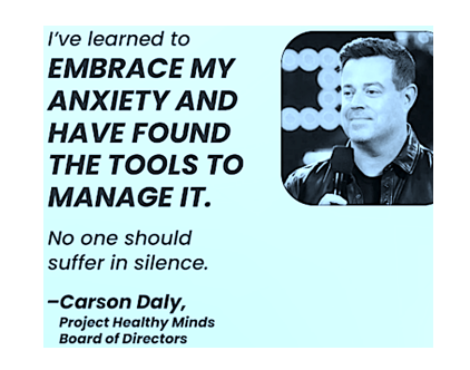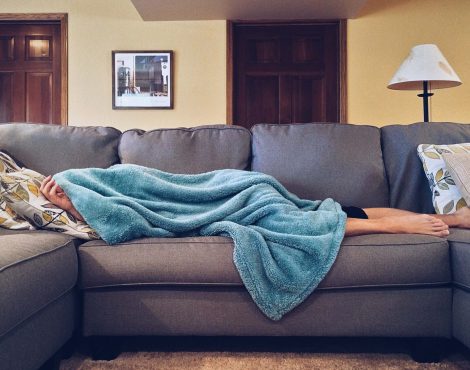There is perhaps nothing more unpleasant than experiencing a panic attack. Sudden, acute anxiety can manifest in terrifying physical symptoms—and can even feel like a heart attack for some people.
The good news is, there are several things you can do at the outset of a panic attack to quell it, and reinstate a sense of calm.
Panic attack versus anxiety attack
Before we dive into coping mechanisms for dealing with feelings of panic, it’s important to first understand the difference between a panic attack and an anxiety attack—which are often used interchangeably.
While both spur a rapid heart rate, shortness of breath and feelings of distress, panic attacks are generally more severe, and can occur entirely unprovoked. Meanwhile, anxiety attacks are usually tied to a distinct trigger or perceived threat.
With anxiety attacks, symptoms tend to build up over a period of time, and last for longer, while symptoms associated with panic attacks subside shortly after they start. In sum, panic attacks tend to be more acute and brief, while anxiety attacks are longer lasting and less severe.
Signs and symptoms
- Increased heart rate
- Chest pain
- Shortness of breath
- Dizziness
- Nausea
- Shaking
- Trembling
- Detachment from reality
What spurs anxiety and panic attacks?
As previously mentioned, anxiety attacks are generally caused by a perceived threat, whereas panic attacks can come on more randomly.
That said, a person is more at risk of experiencing either type of attack as a result of:
- Addiction issues, and withdrawal from drugs and/or alcohol
- Certain medications
- Trauma-related triggers
- Overuse of stimulants, including caffeine
- Chronic medical conditions, such as diabetes, heart disease or thyroid issues
- Mental illness, including anxiety, depression or bipolar disorder
How to stop panic and anxiety attacks
- Breathe: Focusing on your breathwork is arguably the best thing you can do when it comes to quelling anxiety. Since panic attacks can cause chest pain and shortness of breath, deep breathing can immediately ease the tension in the body, and bring the anxiety under control. The key is to breathe slowly, and count to four as you inhale and exhale.
- Focus on an object: Shifting focus from your feelings of anxiety to an unrelated object is a good way to quiet distressing thoughts. Focusing on one thing in particular—whether it’s a piece of art or furniture—can stave off other triggering stimuli. If you suffer from recurring panic attacks, it’s good to carry around a small item—such as a seashell or stone—that can help you focus your thoughts elsewhere when anxiety takes over.
- Relax your muscles: Progressive muscle relaxation is a common technique used to address anxiety and panic attacks. Essentially, all you have to do is tense up your various muscle groups for five seconds, then slowly release them for 10 seconds. This has the same soothing effect as deep breathing, and is intended to make you feel loose and tranquil.
- Seek soothing sounds: Whether it’s listening to music or repeating a mantra, focusing on soothing sounds can help a person stop panicking. If you are someone who suffers from panic disorder or anxiety, it’s useful to find sayings—such as “this too shall pass”—that bring about a sense of calm when spoken out loud, or certain songs that spark joy.
- Walk around: Sometimes, sitting still can be the worst thing to do when suffering from a panic attack. Walking around or moving your body is scientifically proven to improve your mood, as your body releases endorphins during physical activity.
- Relocate to a peaceful place: Sometimes, our environments can trigger panic attacks. If you find yourself in a location that intensifies your feelings of alarm, try to relocate to a peaceful place in close proximity. A change of scenery is often all you need to keep bad thoughts at bay.
- Envision happy thoughts: As difficult as it is to picture something joyful when you’re experiencing a panic attack, sometimes positive thoughts are just what you need to get out of a seemingly never-ending doom spiral. Even something as simple as imagining yourself lying on the beach, or being with a loved one, can evoke a sense of inner peace that can diminish feelings of acute anxiety.
- The 5-4-3-2-1 method: Because panic attacks can distort one’s view of reality, it’s important to employ grounding techniques that awaken all your senses, such as the 5-4-3-2-1 method. The useful technique advises people to do the following:
-
-
- Look at five different objects, focusing on each one for a few minutes.
- Listen for four different sounds in your environment, and think about each one and what makes them unique.
- Touch three different objects and think about what they feel like, and how they differ from one another.
- Identify two different smells in the environment, and consider what they remind you of and where they came from.
- Taste one thing, such as a piece of gum or candy, and think about the flavour.
-
- Talk to someone: Whether it’s a therapist, parent or friend, sometimes talking to someone amid a panic attack can help bring you back to reality, and remind you that everything will be okay. Being with another person—even if it’s over the phone—can make you feel less isolated and more supported in a moment of vulnerability.
- Take medication if prescribed: If you’ve suffered from an episode of panic or anxiety in the past, your doctor may prescribe fast-working medications, such as Valium or Xanax, which can almost immediately instill a sense of zen. Although these medications are helpful and sometimes needed, they should be used sparingly, as they can be very addictive.
How to prevent panic and anxiety attacks
-
- Know yourself: Being aware of your triggers is a really important tool to prevent panic. Also, understanding your mental health status more broadly can help you heal and navigate the best path forward. Taking YMI’s survey, crafted by scientists, is a great place to start.
- Seek professional support: Consulting with a counselor is a great way to bolster your mental health, thereby reducing the risk of experiencing a panic attack. Mental health professionals can furnish you with the personalized coping mechanisms to help you move through triggering situations with ease.
- Meditation and breathing exercises: Breathwork isn’t only important in the midst of a panic attack—it’s also a useful preventative measure. Engaging in daily meditations, yoga classes and other breath-focused rituals can help you harness the power of your breath, so you can use it in a pinch when you need it most.
- Eat well: Diet plays a big role in our overall mental health. If you suffer from anxiety attacks, avoiding foods that tend to spur glucose spikes—such as candy and soda pop—is important.
- Cut the caffeine: Regardless of how much you love your morning cup of joe, excessive caffeine consumption can contribute to jitteriness and anxiety. Try to monitor your intake, and reduce it if you start to notice your anxiety spiking.
- Exercise regularly: As already mentioned, movement is a magical force for mental health. Penciling in regular exercise will work to prevent you from panicking, and help you manage your mind as you move through life.



